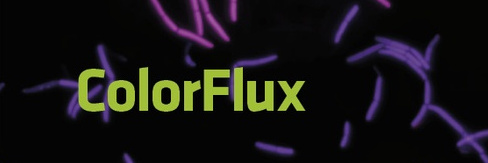
How does it work?
ColorFlux is a cationic compound that quickly penetrates Gram + bacteria through passive diffusion and is efficiently expelled out of the cell depending on efflux activity. ColorFlux staining was shown to reflect the activity of well-characterized efflux pumps from the major facilitator superfamily and ATP-binding cassette families in a variety of Gram+ bacteria:
- NorA, MepA, MepB, PatA, PatB (Staphylococcus aureus & Streptococcus pneumoniae)
- BmrA (Bacillus Subtilis)
After incubating bacteria with ColorFlux for 15 minutes, a steady-state level is reached and relative levels of efflux activity can be quickly assessed by looking at cell pellet color. It is also possible to read fluorescent signals for a precise quantification of efflux levels. Alternatively, kinetics of ColorFlux accumulation can be monitored by flow cytometry.
ColorFlux staining of MepA&B mutants in Staphylococcus aureus

Left graph shows the fluorescence signals detected for each strain using an Ex=530nm, and right graph shows corresponding fluorescence intensity values obtained for each strain at Em=645nm. WT = Wild Type strains, MepA1B+++ = MepA&B overexpressing strains.
Credits: Mrunal Patil & Jean-Michel Bolla, Aix-Marseille Université – 2023
Simplified Protocol

Frequently Asked Questions
Is ColorFlux safe to handle?
Contrary to ethidium bromide, ColorFlux is a non-toxic compound that you can safely handle on the bench and dispose of. It is a particularly useful tool for training purposes & on-field applications.
Can I use ColorFlux in Gram- bacteria?
ColorFlux has been initially developed for Gram+ bacteria because the resulting bacterial coloration after incubation with ColorFlux reflects relative levels of efflux pump activity. Indeed, the fast influx/slow efflux properties of Gram+ bacteria allow ColorFlux to be quickly internalized and then expelled as a function of efflux, resulting in different shades of red that are representative of relative levels of efflux activity.
In Gram- bacteria, the situation is a bit different: because they tend to have a slow influx/fast efflux profile, ColorFlux will be instantaneously expelled from the bacteria as soon as some pumps are present. Therefore, although bacteria without pumps will turn red, it won’t always be possible to distinguish between WT strains and those with enhanced efflux as they will always turn white. This was tested in E.coli, in which WT strain turned white and mutants with ArcAB pump deleted turned red. Some preliminary tests combining ColorFlux with compounds to reduce efflux pump activity, i.e. CCCP, have shown promising results and might help getting relative efflux level measurements in Gram- bacteria. However, precise concentrations & timing to use are yet to be determined for each particular bacterial species and efflux pump involved.
To sum up, the applicability of ColorFlux in Gram- bacteria will depend on the intended application. While ColorFlux can be useful as a tool to quickly check for the presence/absence of efflux pumps (i.e. to validate efflux pump knock-out mutants), some protocol optimization will be required if you are aiming at comparing relative efflux activity levels between strains, or to detect resistant bacteria.
If you have any questions about this item or any of our other items, contact us here.
